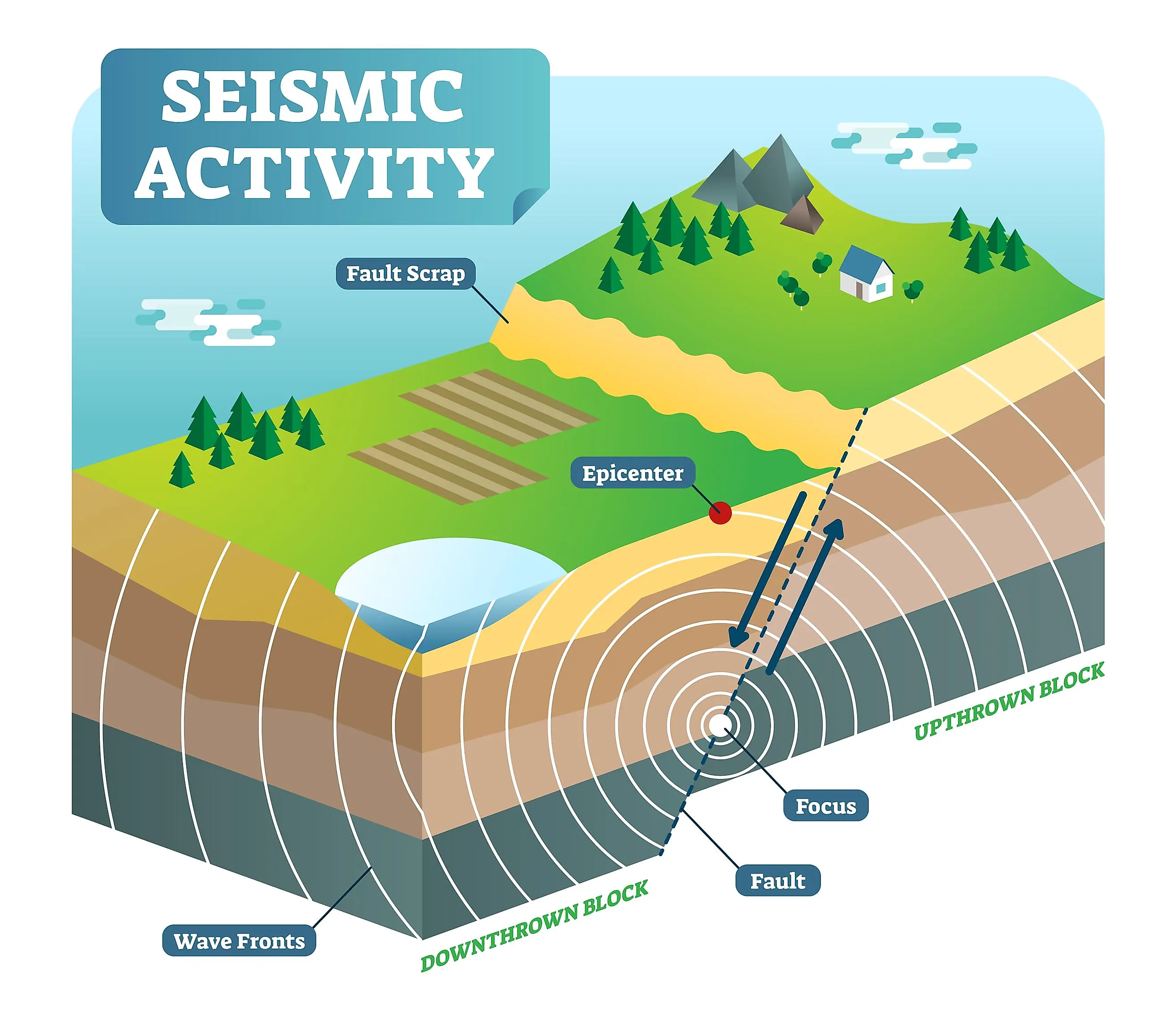
What Causes Earthquakes?
While it is impossible to predict when and where earthquakes will occur, we can understand why they happen. Earthquakes take place due to movements within the Earth's crust, resulting in shaking, shifting, or cracking of its surface. These “quakes” are caused by the passage of seismic waves through the Earth, causing the earth to shift, buckle, or wave. Seismic waves occur when energy trapped within the Earth’s crust escapes.
While this phenomenon can happen in various ways, it is usually caused by pieces of the Earth's crust bumping into or sliding under one another. For this reason, earthquakes, and seismic activity tend to occur along plate borders and edges.
Table of Contents
| Section | Description |
|---|---|
| Tectonic Plate Movement |
How plates move, the movement's impact on seismic activity. |
| Types of Seismic Activity |
Definition of Primary waves, Secondary waves, Love waves, and Rayleigh waves |
| Global Regions Most Prone To Earthquakes |
Locations and seismic activity of The Ring of Fire and The Alpide Belt |
Different Types And Names Of Earthquakes
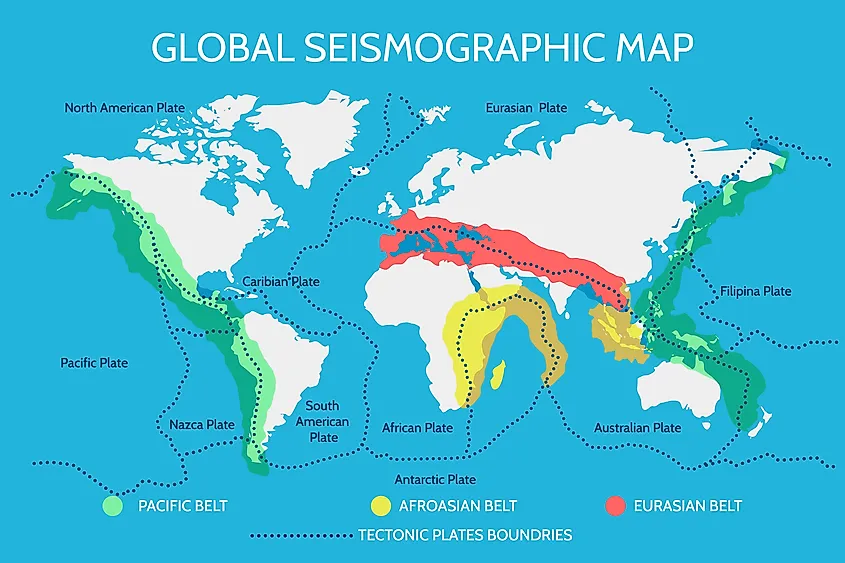
Earthquakes be divided into four subcategories that expand and differ from tectonic plate movements alone: Tectonic, Volcanic, Collapse, and Explosion. However, Tectonic earthquakes are the most typical to occur. Furthermore, Earthquakes can also referred to by various names such as quakes, tremors, temblors, shakes, foreshocks, aftershocks, upheavals, and convulsions.
Tectonic Earthquakes
Rock plates floating in molten rocks or tectonic plates, make up the Earth's crust. Because they are free and not fixed, these plates shift and bump into each other over time. The movements of these plates are so slow, that they normally cannot be felt by humans, but rather move incrementally over many years, decades over centuries. The plates have theoretically been in motion since the birth of the earth, and have shifted very gradually over time. Despite their slow movement, these shifts in the plates sometimes cause major geological events that can be felt on the surface of the Earth. Great amounts of energy can become trapped within the Earth, and as plates shift or collide, this energy can be released. This energy, known as seismic energy, causes the waves of energy to move through the earth, or along the earth’s surface, resulting in a tremor or earthquake.
Volcanic Earthquakes
Volcanic earthquakes occur in conjunction with volcanic activity. When magma moves within a volcano, it can cause the surrounding rocks to crack, leading to seismic events. These earthquakes are usually localized around volcanic regions and can serve as precursors to eruptions. The release of pressure and the movement of magma are the primary causes of these tremors, which can vary in intensity from minor shakes to powerful temblors.
Collapse Earthquakes
Collapse earthquakes result from the collapse of underground structures such as caves, mines, or large sinkholes. These events are typically small in scale compared to tectonic or volcanic earthquakes but can still cause significant localized damage. The sudden collapse of these voids leads to a release of energy that generates seismic waves, causing the ground to shake.
Explosion Earthquakes
Explosion earthquakes are triggered by the detonation of large explosives, such as those used in mining operations or during military activities. The sudden release of energy from these explosions creates shock waves that propagate through the ground, mimicking natural seismic activity. Although less common, these quakes can be just as powerful and damaging as their natural counterparts.
Types Of Seismic Activity
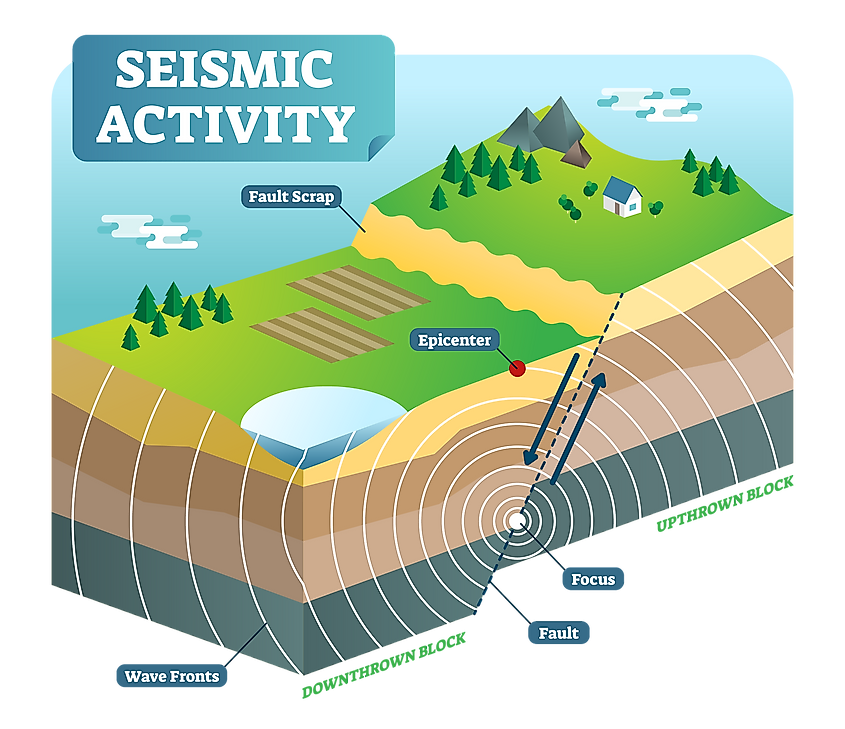
Seismic activity, or the energy released from the earth’s core in bursts of energy waves, can be classified into four types. Seismic waves are vibrations caused by earthquakes, explosions, or extreme bursts of energy. These waves either originate inside the Earth or occur along its surface. Seismic waves can be classified into one of four different types, depending on the location of the waves, as well as the direction and pattern of the wave’s movement. The four categories are: Primary, or P waves; Secondary, or S waves; Love, or Q waves; or Rayleigh waves.
Primary Waves
Primary waves, or P waves, are the fastest-moving waves generated by seismic activity. Because of this, they are the first type of wave registered on a seismographic, which can be used to predict and/or record earthquakes and other such activity. P waves are elastic in nature, meaning they create compression and expansion within whatever media is transmitting the energy. This means the liquid, solid, or gas through which the seismic waves are traveling will experience a back-and-forth motion. The speed of these waves is approximately 4 mi/s (6 km/s) through surface rock and roughly 6 mi/s (10 km/s) nearer the core. The speed differs due to the composition of the rock through which it is passing, as well as changes in pressure which occur deeper within the Earth.
Secondary Waves
Secondary waves are more commonly referred to as S waves or transverse waves. These types of seismic waves move through media in a curved or rolling movement, meaning the medium will move perpendicular to the wave’s direction and rock particles will vibrate at a right angle to that of the wave’s energy. This is known as shear stress. Generally, this means the earth, or medium, will flex up and down in a waving motion, causing crests and troughs, as the seismic energy passes through it. Speeds of S waves range from 2.1 mi/s (3.4 km/s) on the surface, to 4.5 mi/s (7.2 km/s) near the core boundary. S waves do not transmit through liquid, and as such do not occur within the earth’s core, directly.
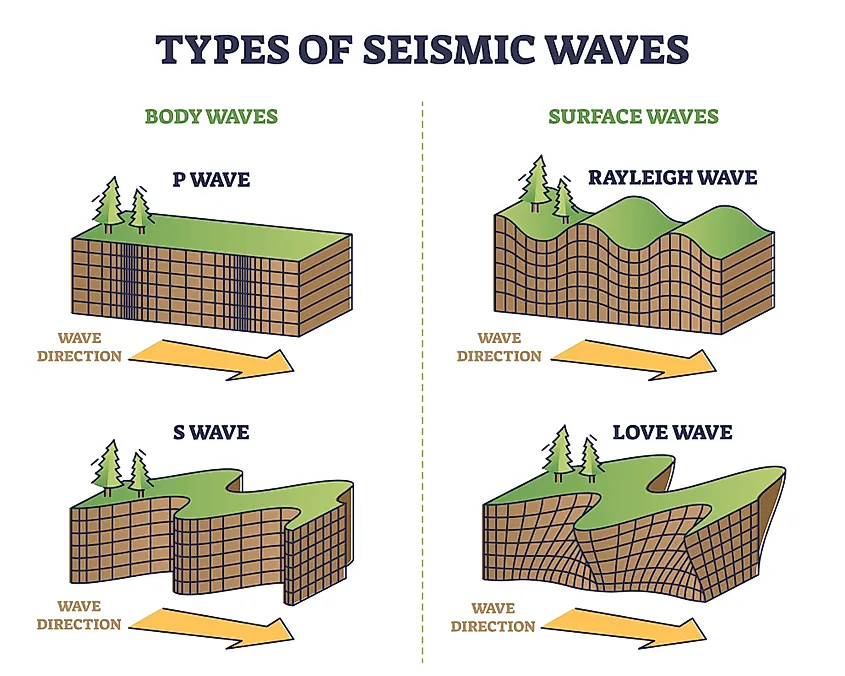
Love waves
Love waves are one of two surface-type waves. Love waves occur when varying degrees of vertical elastic properties experience seismic activity. In this case, the movement of the Earth is perpendicular to the direction of the energy wave. The movement spreads from the energy source in two directions. One side of the s wave is elastic, while the other side borders a vacuum. This causes the earth to shift horizontally, as the ground sinks and rises along bordering areas. Due to their rapid speed (a lower velocity but higher speed than other types of seismic waves), Love waves can cause a much higher reading on the seismic scale. For the same reason, these are generally the most damaging waves, since the earth can shift up and down simultaneously. Additionally, because this is a surface-type wave, the waves remain on the surface of the Earth for prolonged periods, causing sustained damage.
Rayleigh Waves
Rayleigh is the second type of surface wave, also caused by seismic activity. Rayleigh waves cause longitudinal compression and transverse vibration, creating an elliptical motion along the surface. Rayleigh waves move more slowly, and undulate, producing a long duration of seismic activity. Energy is therefore transmitted through the surface of the Earth in both perpendicular and parallel motions. Because Rayleigh waves move in multiple directions and spread out the most, they are very destructive when they pass through the Earth's surface, often resulting in devastating effects.
Global Regions Most Prone To Earthquakes
Ring of Fire
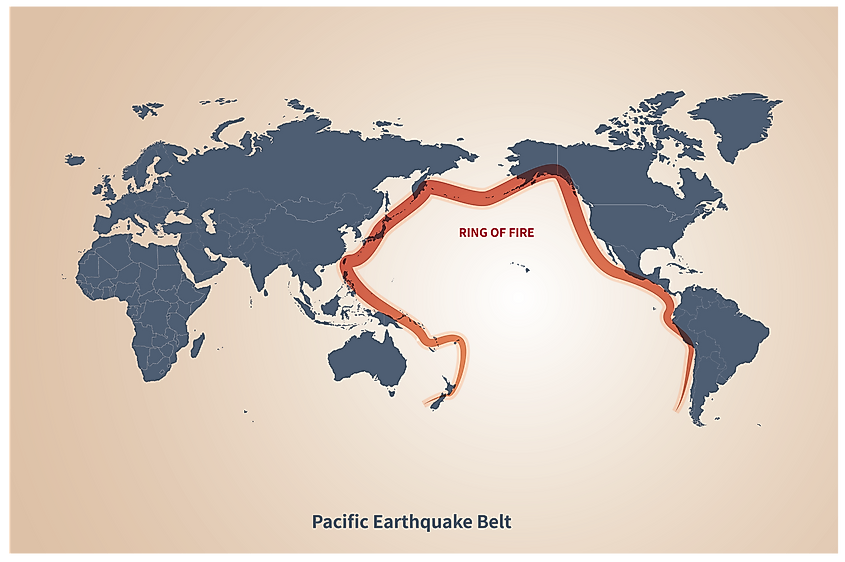
The Pacific Ring of Fire, or the Circum-Pacific Belt, forms the tectonic plate known as the Pacific Plate, one of the largest of the Earth’s tectonic plates. This area has increased earthquake activity and is located in the Pacific Ocean, bordering various Pacific nations such as near New Zealand, Japan, and New Guinea. The Circum-Pacific belt also includes the southern coast of Alaska and the North and South American western coast. The Circum-Pacific Belt is the most earthquake-prone belt on Earth and is responsible for roughly 81% of the planet's earthquakes. Though not all seismic activity is felt by humans, the Circum-Pacific Belt has resulted in a large number of catastrophic or damaging earthquakes and volcanic activity throughout history. Due to its highly volcanic and seismically active border rim, the Circum-Pacific Belt which forms a ring-like border, is known more commonly as the Pacific Ring of Fire.
Alpide Belt
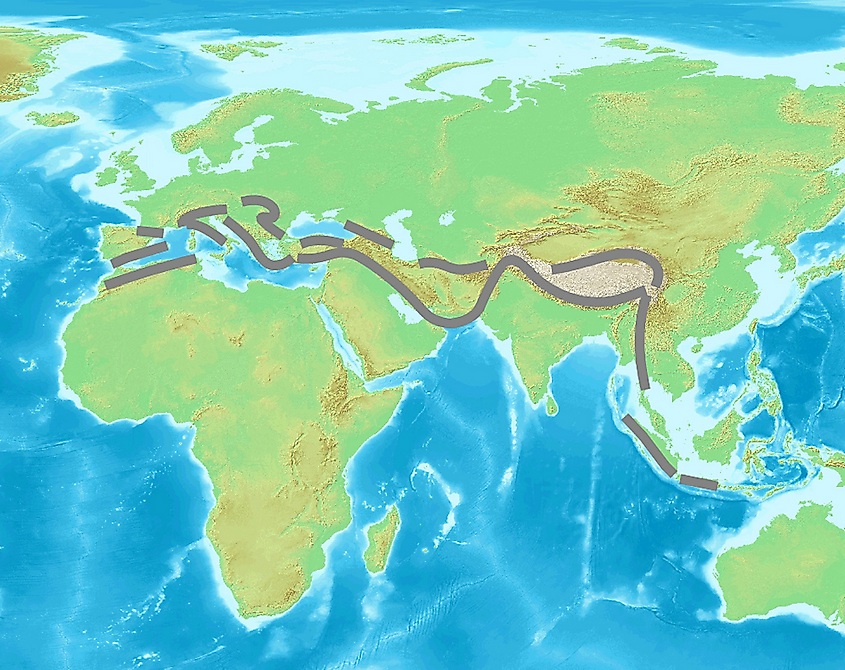
The Alpide Belt is similar to the Circum-Pacific and is another hot spot for seismic activity and volcanic vents and fissures. It connects to the Circum-Pacific belt where the two converge in the East Indies. The Alpide then runs through the Mediterranean and much of Asia. Although this area experiences increased seismic activity compared to other parts of the world, it is still less than the Circum-Pacific belt. The Alpide Belt is an area where several plates, namely the Eurasian, Arabian, Indian, African, and Indo-Australian plates converge. An abundance of plate edges and cracks in the Earth’s surface makes this region a hotspot for earthquakes and seismic activity. The Alpide belt is responsible for roughly 17% of the Earth’s seismic activity. Only a small percentage of earthquakes occur outside the Ring of Fire and Alpide Belt.
Final Thoughts
Earthquakes are an inevitable part of life on Planet Earth. In fact, The National Earthquake Information Center registers approximately 20,000 earthquakes around the world annually. However, earthquakes resulting in damage or natural disasters are, thankfully, not very common. An estimated 100 of these cause damage to the earth and its surroundings, and only one or two of these are classified as a natural disaster. By understanding seismic activity in general, individuals and communities can better prepare themselves to minimize loss of life and property, implement effective disaster response plans, and foster greater resilience in earthquake-prone regions.











